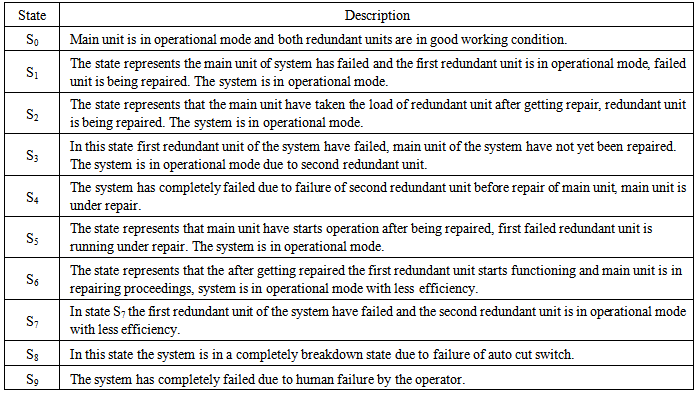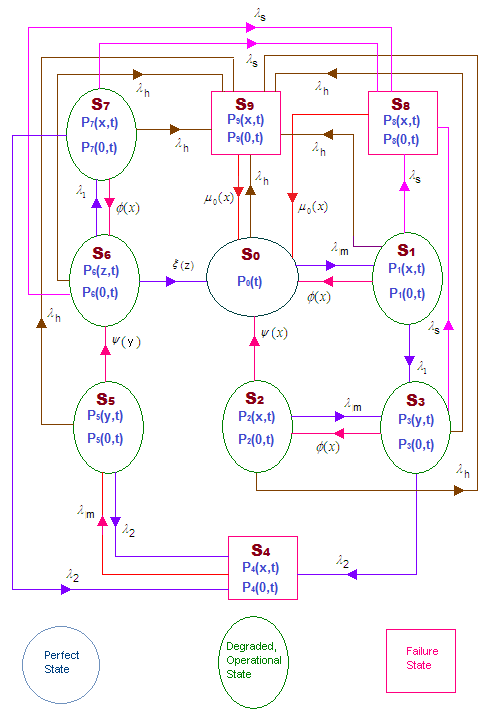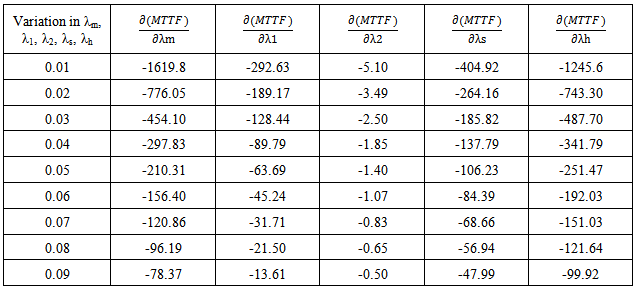-
Paper Information
- Next Paper
- Previous Paper
- Paper Submission
-
Journal Information
- About This Journal
- Editorial Board
- Current Issue
- Archive
- Author Guidelines
- Contact Us
American Journal of Computational and Applied Mathematics
p-ISSN: 2165-8935 e-ISSN: 2165-8943
2014; 4(4): 118-129
doi:10.5923/j.ajcam.20140404.02
Study of Reliability Measures of a Two Units Standby System Under the Concept of Switch Failure Using Copula Distribution
Chiwa Musa Dalah, Vijay Vir Singh
Department of Mathematics & Statistics, Yobe State University, PMB 1144 Gujba Road Damaturu, Yobe State, Nigeria
Correspondence to: Vijay Vir Singh, Department of Mathematics & Statistics, Yobe State University, PMB 1144 Gujba Road Damaturu, Yobe State, Nigeria.
| Email: |  |
Copyright © 2014 Scientific & Academic Publishing. All Rights Reserved.
This paper deals with the study of standby complex system which consists of a main unit and two standby units. The standby units are connected to the main unit via an automatic switch and the system is operated by a human operator. The standby units are connected with the main via a switch in such a way that they can perform the task immediately after failure of main unit. When the standby unit performs the task, the main unit goes for repair and as soon as it is repaired, the load of standby unit again goes to the main unit. In case main unit is not repaired and the first standby unit fails, the second standby unit starts and performs the task. A human operator operates the system and therefore the human failure can appear in state where system is in operational mode. The failure rates are constants and assume to follow exponential distribution but repairs follows two types of distribution (general and Gumbel-Hougaard family copula) distribution. The system is studied by supplementary variable techniques. Some important measures of reliability such as availability, MTTF, sensitivity and profit function have been discussed. Some particular cases have been discussed for different values of different variables.
Keywords: Reliability, Availability, Human failure, Sensitivity analysis, MTTF and profit function
Cite this paper: Chiwa Musa Dalah, Vijay Vir Singh, Study of Reliability Measures of a Two Units Standby System Under the Concept of Switch Failure Using Copula Distribution, American Journal of Computational and Applied Mathematics , Vol. 4 No. 4, 2014, pp. 118-129. doi: 10.5923/j.ajcam.20140404.02.
Article Outline
1. Introduction
- Earlier, the researchers and scientists, who studied the reliability characteristics of repairable complex system, proclaimed their validation of the results in the field of reliability by taking different failure rates and one repair. Most of the researchers assumed that the failed unit can be repaired by a single repairman. Thus, whenever the system / subsystem fails, one type of repair is employed to repair the system, which takes more times for repair the failed unit, resulting the industry /organization suffered with a great loss. The authors in [2, 12, 13, 22] studied the reliability characteristic of a complex systems under and preemptive resume repair policy using copula distribution. The researchers in [4, 5, 11, 15] studied availability of complex system with common cause failure and reliability of duplex standby system by supplementary variable technique [6] and Laplace transform. In case, an ordinary repair facility is employed to repair a failed unit, it will have a great impact on functioning of industry / organization, resulting the organization may suffered a great loss and the manufacturer will lose own market reputation. Human failure arises in the system due to wrongly operation by untrained or inexperience operator. Appearance of human failure completely breakdown the system and can damage many important parts of the system. In this context the authors in [3] studied the automation scenario analysis of human and system reliability under different types failure and general repair policy. Availability of system define the reliability that the system will perform its intended work over a period of time when the repair is available. Thus unavailability is the probability that the system is not able to perform intended task. The authors in [8] studied unavailability analysis of safety system under aging supplementary variable technique and Laplace transform. The authors in [18] studied a complex system by considering interesting modeling of system which having three units at super priority, priority and ordinary under preemptive resume repair policy employing supplementary variable technique and Laplace transform. We observed, in many situations in real life, where more than one repair is possible between two adjacent transition states, the system is repaired by copula distribution [10, 16], which couples the general and exponential distribution. If the main unit of system fails, the standby unit starts performing the task of the failed unit. The system could be repaired by employing general repair, by the repairman with his own capability but whenever the system is in complete failure mode, it should be repaired by employing Copula (Gumbel-Hougaard family copula) distribution. Using this strategy, the authors in [7, 14, 17, 19] studied the reliability characteristics of complex systems, which consist of two subsystems with controller and standby complex system with waiting repair policy using Gumbel-Hougaard family copula distribution. The automatic controlled switch play an important role in improvement the reliability of a repairable system. The prime aim in any industry or organization is to gain more profit with least expenditure. Therefore, when the system is in operational mode via standby unit, it should be repaired by ordinary repair facility and whenever the system is in completely breakdown mode, it should be repaired by copula. Recently the authors in [20, 21] studied the reliability measures of a standby complex system with different types of failure under waiting repair discipline using Gumbel-Hougaard family Copula distribution by considering two types of failures i.e. partial failure (minor and major) and complete failure. Either earlier the researchers ignored the concept of switch failure or the concept of general repair policy had employed to repair the failed unit / subsystems.Therefore, in this paper, we have paid our attention on the study of complex system, which consists of two standby redundant units under the concept of an auto-cut switch and human failure. We have analyzed the system for different situation where the systems have one standby unit, ignoring the switch failure and the human failure. Initially, the main unit starts functioning and on failure of main unit, the first standby unit takes its load and the available repairer starts repairing the failed unit. In case the failed unit repaired before failure of standby unit, it takes load of standby unit and the standby unit goes for standby mode. If the first standby unit fails before repair of main unit then second standby unit takes load of first standby unit and repair in continuous will be given to main failed unit. If main unit is repaired before the failure of second standby unit, it start functioning due to auto cut device, repair is assigned to first failed unit and then to second unit. Thus the main unit will never will be in non-operational mode, it will be in either operational mode or under repairing. The system will be in completely failure mode in the following situations: 1) both standby units fail before repairing of the main unit, 2) Switch fails at any instant during operational mode, 3) The human failure occurs at any stage when the system is in operational mode. Human operator operates the system; the human error can arise at any stage when the system is in operational mode.All failure rates are assumed to be constants and follows exponential distribution, but the repair follows two types of distribution namely: General distribution and Gumbel-Hougaard family copula distribution. Whenever the system is in partially failed state [S1, S2, S3, S4, S5, S6, S7] of Fig. 2, the general repair is employed but whenever the system is in completely failed state [ S8, S9] of Fig. 2, it is repaired by Gumbel-Hougaard family copula distribution.The researchers mainly paid their attention for the study of some traditional measures including reliability, availability, MTTF and cost analysis which have been studied earlier by varies investigators, using various methods. The study of reliability engineering in not only sufficient up to these measures, but still there are many measures, whose study is also required in the field of reliability theory. This needs study of sensitivity analysis for various measures as demanded by various industries & organizations. Hence fore in the present paper, we have discussed the sensitivity of reliability and MTTF, including the traditional measures. The paper is organized as follows: Section 2 explains the description of mathematical model. Section 3 describes the formulation and solution of mathematical model. The section 4 describes the MTTF of the system. Section 5 sensitivity analysis of reliability and MTTF of described model. Finally, section 6 of the paper describes the interpretation and conclusion of the paper.
2. Mathematical Model Description
2.1. State Description for Mathematical Model
|
2.2. Nomenclature
2.3. Assumption
- The following assumptions are taken throughout the discussion of the model:Initially in S0 state and all units as well as switch of system is in good working condition.The system works successfully till redundant units are is in working condition.The system fails if both redundant units fail before repair of main unit.The switch is instaleous and auto cut it did not take time for switching to redundant unit.The system can be repaired when it is in degraded state or completely failed state.All failure rates are constant and they follow an exponential distribution.Human failure /complete failure& switch failure of the system needs immediate repairing, there for it is repaired by Gumbel-Hougaard family copula.It is assumes that repaired system works like a new system and there will be no damage done due to repair.As soon as the failed unit gets repair it ready to perform the task with full efficiency.
2.4. System Configuration
2.5. State Transition Diagram of Model
3. Formulation and Solution of Mathematical Model
3.1. Mathematical Formulation of Model
- By the probability of considerations and continuity of arguments, we can obtain the set of difference differential equations governing the present mathematical model as shown in appendix 1.Appendix 1. should be here:Solving (21)-(29), with help of equations (30) to (38) one may get,
 | (39) |
 | (40) |
 | (41) |
 | (42) |
 | (43) |
 | (44) |
 | (45) |
 | (46) |
 | (47) |
 | (48) |
 Where,
Where,  The Laplace transformations of the probabilities that the system is in up (i.e. either good or degraded state) and failed state at any time is as follows:
The Laplace transformations of the probabilities that the system is in up (i.e. either good or degraded state) and failed state at any time is as follows: | (49) |
 | (50) |
3.2. Particular Cases
- A. Availability Analysis: For particular cases the study of availability is focus on following cases,A1. Availability (Availability of system), A2. Availability (Switch is ignore) & A3. Availability (Human failure is ignore);When repair follows exponential distribution, setting
 taking the values of different parameters as λm=0.03, λ1=0.02, λ2 = 0.015, λh = 0.012, λs = 0.025,
taking the values of different parameters as λm=0.03, λ1=0.02, λ2 = 0.015, λh = 0.012, λs = 0.025,  , θ = 1, x = 1, in (49), then taking the inverse Laplace transform, one can obtain,
, θ = 1, x = 1, in (49), then taking the inverse Laplace transform, one can obtain, | (51A1) |
 | (51A2) |
 | (51A3) |
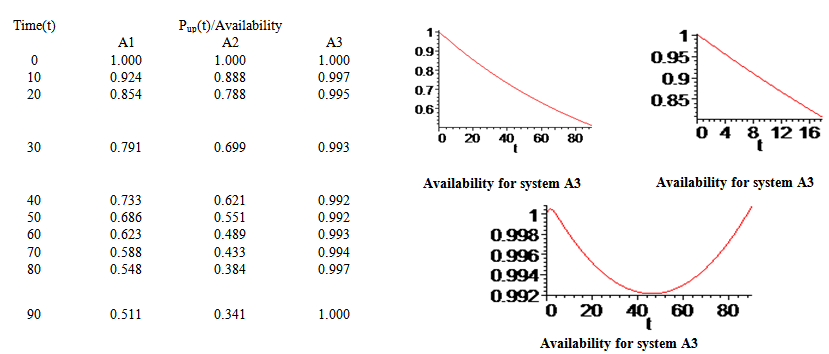 | Figure 3. Availability as function of time |
 | (52a) |
 | (52b) |
 | Figure 4. Reliability as function of time |
4. Mean Time to Failure (MTTF)
- Taking all repairs zero and the limit as s tends to zero in (49) for the exponential distribution; one can obtain the MTTF as:
 | (53) |
 | Figure 5. MTTF as function of Failure rate |
|
 | Figure 6. For sensitivity of reliability as a function failure rates |
|
5. Sensitivity Analysis
5.1. Sensitivity of Reliability
- The sensitivity of the reliability can be characterize as the rate of change of reliability with respect to input factor, most regularly defined as the partial derivative of reliability with respect to failure rates. Thus, the sensitivity of reliability and MTTF can be defined as the rate of variation of outcome measure with respect to input factor. There for the sensitivity of reliability can be obtain by differentiating the (52a) and (52 b) with respect to λm, λ1, λ2, λs, λh., and setting λm=0.03, λ1=0.02, λ2 = 0.015, λh = 0.012, λs = 0.025 one can obtain Table 6 and Figure 6, respectively for sensitivity of reliability. Sensitivity of MTTF can be obtained by making partial derivative of MTTF with respect to failure rates. Results are highlighted as in Table and corresponding Figure.7 respectively.
 | Figure 7. Sensitivity of MTTF as a function of failure rates |
5.2. Sensitivity of MTTF
- Sensitivity analysis for change in MTTF resulting from changes in the system parameters i.e. system failure rates λm, λ1, λ2, λs, λh. By differentiating Equation (51) with respect to failure rates λm, λ1, λ2, λs, λh respectively one get values of


6. Cost Analysis
- Let the service facility be always available, then expected profit during the interval [0, t) is;
 | (54) |
 | (54A1) |
 | (54A2) |
 | (54A3) |
 | Figure 8. Expected profit as function of time |
7. Interpretation of Results and Conclusions
- Fig.3 provides information how the availability of the complex repairable system changes with respect to the time when failure rates are fixed at different values. When failure rates are fixed at lower values λm = 0.03, λ1 = 0.02, λ2 = 0.015, λs = 0.025, λh = 0.012, availability of the system decreases and ultimately becomes steady to the value zero after a sufficient long interval of time. Hence, one can safely predict the future behavior of a complex system at any time for any given set of parametric values, as is evident by the graphical consideration of the model. Availability of system for which human failure is ignored is decreases up to time t=60, but it again start increasing again. In figure.4 provides the variation in reliability of non-repairable system. Fig. 5, yields the mean-time-to-failure (M.T.T.F.) of the system with respect to variation in λm, λ1, λ2, λs, and λh respectively when the other parameters have been taken as constant. The variation in MTTF corresponding to failure rates λs, λp are almost is very closure but corresponding to λB, λh the variation is very high which indicates that these both are more responsible to proper operation of the system. The measure of sensitivity of reliability and MTTF has discussed in section C of paper which rate of change of the value of output variable with change of output variable. When revenue cost per unit time K1 is fixed at 1, service costs K2 = 0.5, 0.25, 0.15, 0.10, 0.05, profit has been calculated and results are demonstrated by graphs in Fig.8. A critical examination from Fig.8 reveals that expected profit increases with respect to the time when the service cost K2 fixed at minimum value 0.05. Finally, one can observe that as service cost increase, profit decrease. In general, for low service cost, the expected profit is high in comparison to high service cost.
 | (1) |
 | (2) |
 | (3) |
 | (4) |
 | (5) |
 | (6) |
 | (7) |
 | (8) |
 | (9) |
 | (10) |
 | (11) |
 | (12) |
 | (13) |
 | (14) |
 | (15) |
 | (16) |
 | (17) |
 | (18) |
 | (19) |
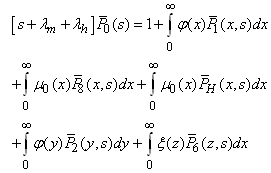 | (20) |
 | (21) |
 | (22) |
 | (23) |
 | (24) |
 | (25) |
 | (26) |
 | (27) |
 | (28) |
 | (29) |
 | (30) |
 | (31) |
 | (32) |
 | (33) |
 | (35) |
 | (36) |
 | (37) |
 | (38) |
References
| [1] | A. Ghasemi; S. Yacout and M.-S. Ouali (2010); Evaluating the Reliability Function and the Mean Residual Life for Equipment with Unobservable States, “IEEE, Transitions on Reliability.”, Vol. 59, Issue 1, pp. 45-54. |
| [2] | A. K. Govil (1974); Operational behaviour of a complex system having shelf-life of the components under preemptive-resume repair discipline, “Microelectronics Reliability”, Vol. 13, pp. 97-101. |
| [3] | Alistair G. Sutcliffe (2007); Automating Scenario Analysis of Human and System Reliability, IEEE Transactions on Systems, Man and Cybernetics-Part A: Systems and Humans, Vol.37 (2), pp.249-261. |
| [4] | B. S. Dhillon, and N. Yang (1992); stochastic analysis of standby systems with common cause failures and human errors. Microelectronics Reliability, Vol.32 (12), pp 1699-1712. |
| [5] | B. S. Dhillon, and N. Yang (1993); Availability of a man-machine system with critical and non-critical human error. Microelectronics Reliability, Vol.33 (10), pp. 1511-1521. |
| [6] | D. R. Cox (1995); “The analysis of non-Markov stochastic processes by the inclusion of supplementary variables”, Proc. Camb. Phil. Soc. (Math. Phys. Sci.), Vol. 51, pp. 433-44. |
| [7] | D. K. Rawal, M. Ram & V.V. Singh (2014); “Modeling and availability analysis of internet data center with various maintenance policies”. IJE Transactions A: Basics Vol. 27, No. 4. pp. 599-608. |
| [8] | E. A. Oliveira, A.C.M. Alvim and P. F. Frutuoso e Melo (2005); “Unavailability analysis of safety systems under aging by supplementary variables with imperfect repair”. Annals of Nuclear Energy, Vol.32, p p. 241-252. |
| [9] | E. J. Vanderperre (1990); Reliability analysis of a two-unit parallel system with dissimilar units and general distributions. Microelectronics Reliability, Vol.30, pp. 491-501. |
| [10] | H. Gennheimer (2002); “Model Risk in Copula Based Default Pricing Models, Working Paper Series”, Working Paper No. 19, Swiss Banking Institute, University of Zurich and NCCR FINRISK. |
| [11] | M. Ram, and S. B. Singh (2010); “Analysis of a Complex System with common cause failure and two types of repair facilities with different distributions in failure” International Journal of Reliability and Safety, Vol. 4(4), pp.381-392. |
| [12] | M. Ram, and S. B. Singh (2008); “Availability and Cost Analysis of a parallel redundant complex system with two types of failure under preemptive-resume repair discipline using Gumbel-Hougaard family copula in repair”, International Journal of Reliability, Quality & Safety Engineering, Vol.15 (4), pp. 341-365. |
| [13] | M. Ram, and S. B. Singh (2010); “Availability, MTTF and cost analysis of complex system under preemptive-repeat repair discipline using Gumbel-Hougaard family copula”. International Journal of Quality & Reliability Management, Vol. 27(5), pp. 576-595. |
| [14] | M. Ram, S. B. Singh& V.V. Singh (2013); “Stochastic analysis of a standby complex system with waiting repair strategy” “IEEE Transactions on System, Man, and Cybernetics Part A: System and humans” Vol.43, NO. 3. pp, 698-707. |
| [15] | P. P. Gupta, and M. K. Sharma (1993); “Reliability and M.T.T.F evaluation of a two duplex-unit standby system with two types of repair”. “Microelectronics Reliability”, Vol. 33(3), pp. 291-295. |
| [16] | R. B. Nelsen (2006); “An Introduction to Copulas” (2nd edn.) (New York, Springer). |
| [17] | V. V. Singh, S B Singh, M. Ram & C.K. Goel (2012); “Availability, MTTF and Cost Analysis of a system having Two Units in Series Configuration with Controller”. International Journal of System Assurance Engineering and Management, Volume 4, Issue 4, pp 341-352. |
| [18] | V. V. Singh, S. B. Singh, M. Ram and C. K. Goel (2010); “Availability analysis of a system having three units super priority, priority and ordinary under preemptive resume repair policy”, International Journal of Reliability and Applications, Vol. 11(1), pp.41-53. |
| [19] | V.V. Singh, M Ram & Dilip Rawal (2013); “Cost Analysis of an Engineering System involving subsystems in Series Configuration”. “IEEE Transactions on Automation Science and Engineering”. Vol; 10, Issue; 4.pp 1124-1130. |
| [20] | V .V. Singh, Jyoti Gulati (2014); “Availability and cost analysis of a standby complex system with different type of failure, under waiting repair discipline using Gumbel-Hougaard copula”. IEEE, www. ieeexplore.org. DOI 10.1109/ICICICT. 2014. 6781275. PP (180-186). |
| [21] | V. V. Singh, Dilip Kumar Rawal (2011); “Availability analysis of a system having two units in series configuration with controller and human failure under different repair policies”, Inter. J. of Scient. Eng. Res. Vol 2 (10), pp. 1-9. |
| [22] | X. Cai, X. Wu and X. Zhou (2005); “Dynamically Optimal Policies for Stochastic Scheduling Subject to Preemptive- Repeat Machine Breakdowns”, IEEE Transactions On Automation Science and Engineering, Vol. 2, No.2, pp. 158-172. |
 Abstract
Abstract Reference
Reference Full-Text PDF
Full-Text PDF Full-text HTML
Full-text HTML